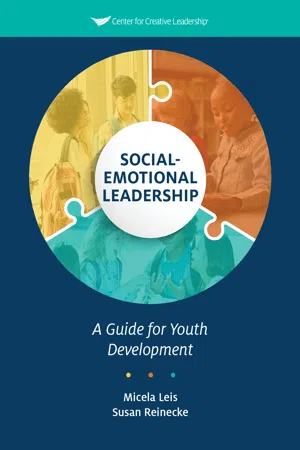
eBook - ePub
Social-Emotional Leadership: A Guide for Youth Development
Micela Leis, Susan Reinecke
This is a test
Partager le livre
- 182 pages
- English
- ePUB (adapté aux mobiles)
- Disponible sur iOS et Android
eBook - ePub
Social-Emotional Leadership: A Guide for Youth Development
Micela Leis, Susan Reinecke
Détails du livre
Aperçu du livre
Table des matières
Citations
À propos de ce livre
Today's youth are tomorrow's leaders. The better they can understand themselves and work effectively with others, the greater impact they can make on the world around them. Based on research from the Center for Creative Leadership, Social-Emotional Leadership: A Guide for Youth Development identifies 14 student leadership attributes and offers tools for adults to use to develop social-emotional leadership in youth inside and outside the classroom.
Foire aux questions
Comment puis-je résilier mon abonnement ?
Il vous suffit de vous rendre dans la section compte dans paramètres et de cliquer sur « Résilier l’abonnement ». C’est aussi simple que cela ! Une fois que vous aurez résilié votre abonnement, il restera actif pour le reste de la période pour laquelle vous avez payé. Découvrez-en plus ici.
Puis-je / comment puis-je télécharger des livres ?
Pour le moment, tous nos livres en format ePub adaptés aux mobiles peuvent être téléchargés via l’application. La plupart de nos PDF sont également disponibles en téléchargement et les autres seront téléchargeables très prochainement. Découvrez-en plus ici.
Quelle est la différence entre les formules tarifaires ?
Les deux abonnements vous donnent un accès complet à la bibliothèque et à toutes les fonctionnalités de Perlego. Les seules différences sont les tarifs ainsi que la période d’abonnement : avec l’abonnement annuel, vous économiserez environ 30 % par rapport à 12 mois d’abonnement mensuel.
Qu’est-ce que Perlego ?
Nous sommes un service d’abonnement à des ouvrages universitaires en ligne, où vous pouvez accéder à toute une bibliothèque pour un prix inférieur à celui d’un seul livre par mois. Avec plus d’un million de livres sur plus de 1 000 sujets, nous avons ce qu’il vous faut ! Découvrez-en plus ici.
Prenez-vous en charge la synthèse vocale ?
Recherchez le symbole Écouter sur votre prochain livre pour voir si vous pouvez l’écouter. L’outil Écouter lit le texte à haute voix pour vous, en surlignant le passage qui est en cours de lecture. Vous pouvez le mettre sur pause, l’accélérer ou le ralentir. Découvrez-en plus ici.
Est-ce que Social-Emotional Leadership: A Guide for Youth Development est un PDF/ePUB en ligne ?
Oui, vous pouvez accéder à Social-Emotional Leadership: A Guide for Youth Development par Micela Leis, Susan Reinecke en format PDF et/ou ePUB ainsi qu’à d’autres livres populaires dans Business et Industria alimentare. Nous disposons de plus d’un million d’ouvrages à découvrir dans notre catalogue.
Informations
Sujet
BusinessSous-sujet
Industria alimentare
LEADING SELF
In order to lead with others, you must first understand how to lead yourself. This includes being aware of your strengths and challenges and being committed to self-improvement. This section includes information about the following leadership attributes:
ATTRIBUTES | DEFINITIONS |
Self-Aware | can describe what makes them who they are |
Accountable | takes responsibility for their actions |
Resilient | keeps trying if they fail at an important goal |
Integrity | stands up for what they believe in |

“Leading Self means that I am self-aware of what is happening and how I feel. It means that I am growth-minded and open to new ideas. It means that I am motivated in what I do. It means that I am resilient. It means that I am accountable.”
– Middle School Student
Chapter 1
SELF-AWARE

“Being self-aware is being able to control what you say and who you say it to.”
– Eighth Grade Student
“I am aware of both my negative and positive qualities and the areas where I am capable and the areas where I need help.”
– 12th Grade Student
Introduction
Use the information in this section to help you introduce the “self-aware” attribute to students. You can use the question stem “How does this attribute make you a better leader?” to start a discussion with your students and to check for comprehension (see Additional Resources in this chapter for more information to further your personal understanding).
Explaining “Self-Aware” to Students
We all have a mental picture of ourselves—what we believe, how we treat others, what we are good at, and what we may not be so good at. But do you see yourself as others see you? If you asked someone else to describe you, could you accurately predict what that person would say? To be self-aware means understanding who you are, your strengths, and areas in which you can improve. It’s important to understand not only how we see ourselves but also how others see us. Why do you think that is? One reason is that if you understand the areas in which you need to improve, you can ask for help in these areas from other people. Asking for help will allow you to build relationships and work well with others, which is very important for leadership.
What “Self-Aware” Looks Like
Self-aware leaders:
• have an accurate picture of their strengths and weaknesses
• are aware of their feelings
• reflect on and learn from experience
• seek feedback to improve
• are open to criticism and can hear feedback without getting defensive
• work on what they need to learn
• respond well to new situations that require them to stretch and grow
• know what their values are and why they are important to them
• are seen as authentic, attentive, thoughtful, responsive, reflective, and observant
• know how their actions affect others
• adjust their behavior to suit circumstances
What Gets in the Way?
When you are not self-aware, you might see yourself differently than others see you. This may lead to your misreading different situations and not acting appropriately. Your actions can contribute to confusion, frustration, and feelings of being misunderstood. Review the following list and note the items that might give you trouble developing self-awareness.
• You don’t take time to think about how your actions may affect others.
» (Examples: gossiping, bullying, not sharing, taking someone else’s things, etc.)
• You don’t want others to give you feedback.
• You don’t believe you have any room for improvement.
• You think your needs are more important than anyone else’s.
• You respond defensively to feedback.
• People are afraid to tell you things because they don’t want to hurt or offend you.
• You act as if you are someone you are not.
• You have a hard time accepting compliments or positive feedback.
Being able to recognize the positive and negative impact that your words and actions have on others will make you a better social-emotional leader.
Suggestions for Improving “Self-Aware”
Work with your students to discuss and establish some ways to build competency in this attribute. Below is a list to help support this exercise. We encourage you to develop your own strategies or modify these suggestions.
You might also consider doing an activity with your students (see this chapter’s Activity Center for suggestions) or asking them to write about the attribute (see Journal Prompts for suggestions) to help build their understanding. Support is an important part of development, so discuss with your students how you can support each other, as a group or class, to build skill in this leadership attribute.
• Check your awareness. List the characteristics or descriptions of how you hope others see you. For example: kind, considerate, respectful, fun to be around, optimistic, hard-worker, stands up for what you believe in, dependable. Then, ask your accountability partner to write out a list of how they see you. Compare the lists. If your lists do not match, think about ways that you can act that show how you want others to see you.
• Reflect on your personal values. What do you value the most? Where are you willing to compromise? Some of your values are more important to you than others. Think about how your values compare to the values of your family, friends, school, and community.
• Notice how others respond to your actions. If other people respond to your actions in unexpected ways, use that information to think about where your self-awareness may be lacking. Journal about what you might be doing or not doing that might lead to these unexpected responses. Ask a trusted friend or family member for feedback.
• Ask for feedback, and think of it as a gift. What other people tell you about how they see you will help you be more self-aware. Ask others for feedback, listen without being defensive, thank the people who give you feedback, and think of how you can use the feedback to change your actions.
• See change as an opportunity. You can change the beliefs others hold about you and the expectations that they have for your behavior. To make these changes, work on your actions, your approach to different situations, and your understanding about what others need.
• Note how you respond in times of stress. How do you act when you are feeling a lot of pressure or when you are in stressful situations? Every difficult situation or challenge is an opportunity for you to reflect on your experience and grow from it. Take time to think back on the activities of your day, the actions you took, and the choices you made. Decide what changes you can make to react differently in the future.
Activity Center
Here are some suggested activities you can modify to fit your context and the students with whom you work.
• Book introduction. Find a book to read with students that has a character who either demonstrates the “self-aware” attribute or who would have benefitted from being more self-aware, and have students discuss or journal about the character’s behavior (see the Suggested Books section of this chapter for some books that fit this activity).
• Verbal self-portrait. Ask students work with a partner to use words to create a portrait of how they see themselves in terms of their values or actions and how they see their partner (for example: kind, considerate, helps others when they are sad). After they’ve shared their portraits with each other, ask students to divide a piece of paper in half by drawing a line and to create two more self-portraits with words. One of these self-portraits should reflect the title, “This is who I am,” and the other, “This is who I want to be.” Ask students to think about whether they were surprised about anything their partner wrote about them.
• Monologue or poem. Ask students to write a poem or a monologue titled either “This is Who I Am” or “This is Where I Come From” to share with the class. For an example, see George Ella Lyon’s poem “Where I’m From,” which you can access at: http://www.georgeellalyon.com/where.html.
• Johari window. Give students (recommended for students age 16 and older) the Johari Window activity (p. 23). Have t...